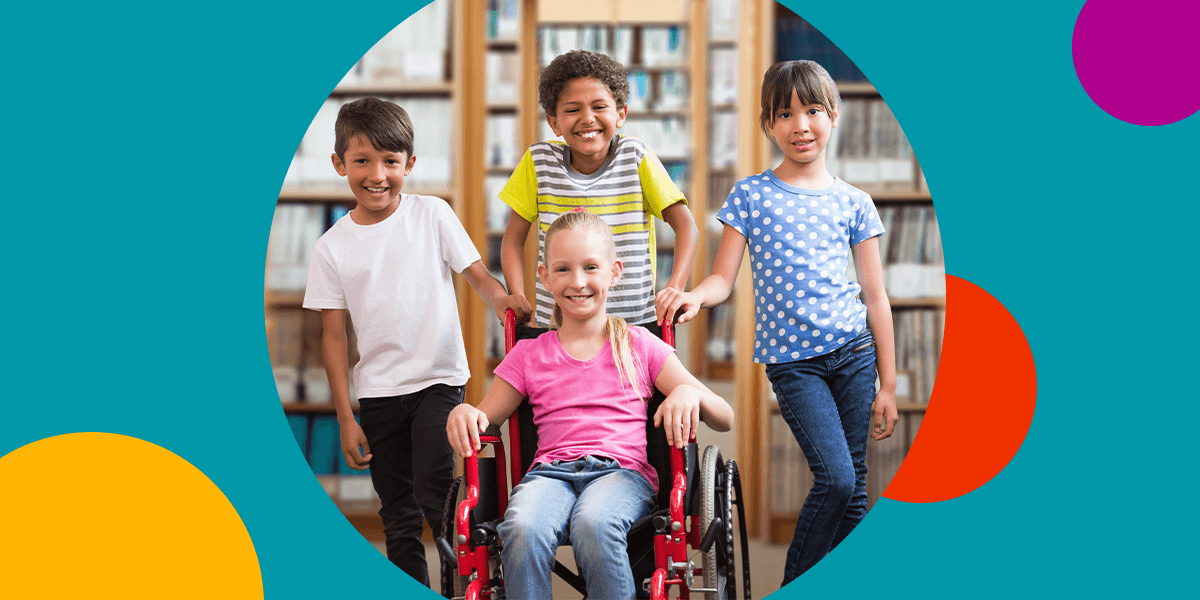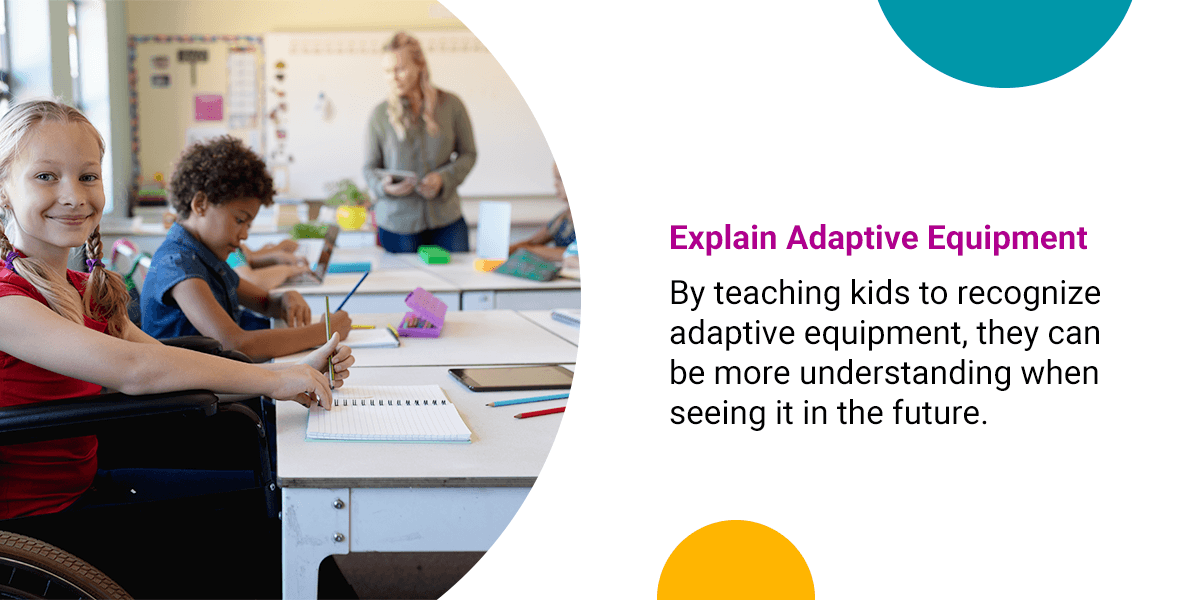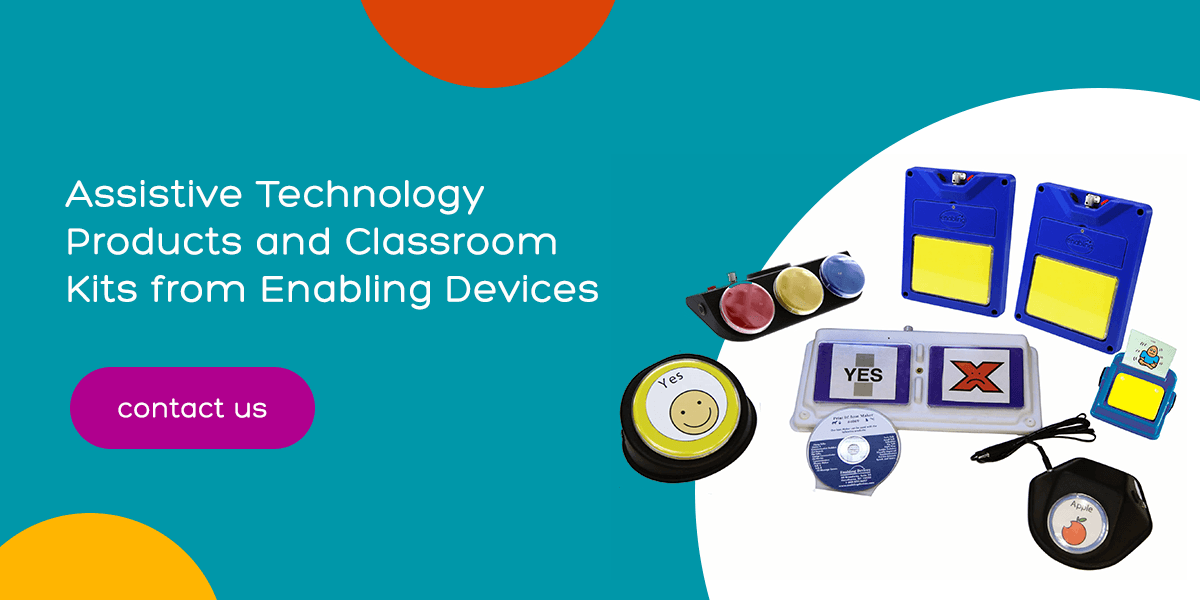In a classroom setting, there is often a mix of children who do and don’t have disabilities. To help every child reach their full potential, teachers must have a strategy for navigating differences in ability and supporting each child in their individual learning journey.
Today, there are approximately 61 million Americans with disabilities. As a teacher, you have the opportunity to show students how to treat others who are different than themselves. Your focus in the classroom impacts how students see themselves and what they prioritize over the school year. Here are tips for teachers on how to support students with disabilities and foster an inclusive classroom.
How Can Teachers Make the Classroom Inclusive?
Teachers face many challenges when managing a classroom. However, setting boundaries and creating systems at the beginning of the school year can go a long way for an inclusive classroom. Think about how you want students to feel, what you want them to learn and how you will accomplish those goals.
Here are six ways you can make your classroom more inclusive for students with disabilities:
1. Accommodate Lessons to Ensure Everyone’s Needs Are Met
It might go without saying, but for teachers to accommodate their students’ needs, they must first understand those needs and limitations. Make a point to coordinate with the school’s specialists, including occupational therapists, speech therapists, school psychologists, special education instructors and reading specialists. You can work together to build inclusive lessons that will provide the needed accommodations for all students.
While a teacher may need to make certain alterations to accommodate a student’s special needs, it’s essential to keep the general theme of the lesson the same for everyone. By engaging them in the same topics and basic activities, you promote an inclusive atmosphere for everyone in the class. When your students have a common goal, they’ll engage with each other more effectively and feel more like a cohesive group.
Depending on your students’ needs, you may also have an additional teacher in the classroom to assist them. Or, you might use specialized technology to obtain information in an alternative fashion. For example, a student who is deaf or hard of hearing may require a visual translation of the lesson or a seat up front to read lips during a lecture. If another teacher is assigned to work with one of the students in the classroom, work closely with them. That way, you can both adequately prepare to instruct the class and meet individual needs.
2. Avoid Stereotypes
Whether you’ve been teaching for two months or twenty years, you may have formed some preconceived notions about students with special needs and how to interact with them. It’s important to start fresh with every student — not every person with disabilities is the same.
Remember that each of your students — regardless of their physical and mental abilities — is a human being. They each learn differently. They each have different likes and dislikes. They each have different ways of engaging with the world around them. When you learn what makes your students tick, you’ll understand how to motivate them and engage with them on their learning journey.
3. Model a Positive Attitude
When you have a positive attitude, you teach your students to face each day with courage, kindness and hard work. Believe each student is capable of succeeding and regularly evaluate your teaching plan for better ways to motivate them.
Although some students struggle more than others, there’s no benefit to blaming a student or their disability for their lack of understanding. There is no such thing as a waste of time. Regardless of how they engage with their class or what information they retain in the long run, your role is to teach them something they didn’t know before and prepare them for what’s ahead.
4. Maintain an Inclusive Atmosphere at All Times
Children will mimic the behavior they see in the adults around them. If a teacher includes all students in activities and strives to maintain an inclusive atmosphere in the classroom, then students will follow suit. If a teacher excludes certain students from certain activities or shows a preference for those they think are “smarter” or “better,” they risk cultivating a divisive classroom.
A great way to create an inclusive environment is to incorporate games and interactive activities into lesson plans. This helps students learn about each other’s strengths and understand their personalities. It’s also a great way to develop unity among students. When children have fun together, it helps them grow closer to each other, regardless of their abilities.
5. Talk About Disabilities With Students in a Healthy Way
Lastly, remember to keep all classroom discussions about disabilities healthy and positive. Teachers can help students form positive feelings about peers with disabilities, instead of fear or awkwardness.
Encourage healthy communication strategies with the following steps:
- Humanize others: When students notice children who are different from them, inspire them to treat them like other classmates. For instance, you could tell students to introduce themselves and ask questions. Remind them of the similarities between everyone despite appearances.
- Normalize confusion: Your students might feel confused about the best way to include or speak to kids with disabilities. Let them know that confusion is okay, but it’s important to overcome it and welcome others.
- Use respect: Emphasize that respect is the most important aspect of all interactions. While it’s okay to ask questions, remind students that everyone’s feelings should come first. They should treat every person they meet with respect and think about how their words might impact others.
You can maintain a positive environment by prioritizing healthy discussions about students with disabilities in the classroom.
6. Have Adaptive Equipment and Assistive Technology in the Classroom
Some of this may depend on each students’ individual needs, but having the appropriate adaptive equipment and assistive technology available in the classroom goes a long way toward effective instruction. Using assistive technology in the classroom ensures that students with varying levels of ability can be included in many different activities.
Not sure what kind of equipment you need? Check out a wide variety of products and classroom kits from Enabling Devices.
How to Interact With Someone Who Has Special Needs
Some children in your classroom may be unsure how to respond to classmates with special needs. For many kids, encountering someone with special needs may be confusing or frightening. You have an opportunity to model loving and respectful behavior for the children in your classroom.
Here are six things you should teach kids in your classroom about how to interact with children who have special needs.
1. Remember That Everyone Is Human
We all want acceptance and to engage with others. How do you show this to a child? Model this behavior in your interactions with everyone at school. The way you treat other teachers, the janitorial staff, and the other students will go a long way toward teaching students that every human being is valuable. When children see this modeled by their teacher, they will be more likely to emulate this behavior with all of their classmates, regardless of any special needs they might have.
With younger children, play is a valuable tool for understanding and connecting with others. Young children form relationships through play and can develop a better understanding of their peers with disabilities when they engage together through play. Look for opportunities for your young child to engage and interact with other children and adults who are different from them.
2. Be Yourself
Many children and adults are unsure how to engage with students who have special needs. The short answer is to just be yourself. A child’s disability does not necessarily change their ability to respond to others around them. For instance, a child with speech and language disabilities can still participate in conversations with others using their adaptive equipment.
At the same time, there’s no need for students to go overboard trying to engage with peers. A child who tends to be quiet but loves to help might do better by offering assistance to a peer with special needs during a classroom activity. A child who tends to be more talkative and outgoing may choose to engage in conversation with a peer who has special needs.
Encourage students to find ways to engage with classmates that are reflective of their personality. Although everyone should step out of their comfort zone from time to time, students don’t have to change their personalities to interact with classmates who have disabilities.
3. Recognize Boundaries
Although it’s important for children to be inclusive of others, it’s also vital that they learn to understand that their classmates may have boundaries and struggles that don’t always go well with a student’s personality. For example, autistic children don’t usually like to be touched. An affectionate child might like to hug or touch other children, but a child with special needs might not welcome touches. Because children spend so much time in the classroom together, they often pick up on these preferences just from watching their classmates. However, it’s still important to remind them to be alert and aware of how their behavior can affect their classmates.
For example, you can teach students about supporting a child who uses a wheelchair at school. Teach them to think of the wheelchair as an extension of their classmate’s body. That means that it’s not okay to lean on the wheelchair, destroy or deface it in any way or ask to ride in it. They should also never grab for the chair or attempt to push their classmate without permission.
4. Use the Universal Language of Music
In some cases, music can be a great way to bridge the gap between classmates of varying abilities and needs. Even if a child is non-verbal or has physical limitations, they can still connect with music because it is universally understood. They can enjoy the antics and voices of their classmates, and they can connect with the words, even to silly songs.
As children grow older, they may also be able to bond over the love of a particular genre of music or a band they both enjoy. This can be especially helpful for tweens and teens who are looking for ways to connect with a classmate with special needs.
5. Don’t Be Afraid to Talk
Even if your students have a nonverbal classmate, you can encourage them to engage in conversation together. Talking to another person demonstrates an interest in them and helps to establish a connection. Students can tell stories or ask about their day. Remind them that it doesn’t have to turn into a 20-minute discussion. Even taking 30 seconds to say “hello” or telling a brief story about something that happened at the bus stop that morning can go a long way.
That being said, teach students to be sensitive to their classmates if they have any hearing loss or sensory issues because conversation in a crowded or loud space may do more harm than good. Guide them to look for opportunities to talk in quiet face-to-face settings, such as during assignments that require students to choose a partner to complete them or inviting them to play an educational game during a free period.
Parents of students with special needs are typically receptive to questions from their child’s classmates. These questions give them the opportunity to inform others and help them develop a more accurate understanding of what makes their child unique. It doesn’t take a well-scripted list of questions to approach another parent. Many times, a simple “Hello” is all you need to open the door to conversation.
6. Recognize Limitations
Children of all ages and stages have their limits. In children with special needs, these limitations are often magnified because of the physical or sensory issues associated with certain conditions. For example, students may have a classmate who is deaf. That student may not be able to follow a conversation in spoken English, but they can still engage in active play at recess. Their classmates can also learn a few basic signs so that they can communicate with them.
If students have a classmate with autism spectrum disorder, you may want to prepare them for how to respond to meltdowns or episodes where they seem to be out of control. When these outbursts happen, children without disabilities can often misunderstand them. Children might react by making fun of or becoming scared of classmates with disabilities.
The truth is that these outbursts are simply a part of their disability. It’s the teacher’s responsibility to prevent and mitigate these outbursts. However, students can cultivate an understanding attitude toward what’s happening and not allow it to mar their opinion of their classmates.
Teaching Kids About Disabilities: Tips for Parents
As a teacher, you can also support parents as they have conversations with their kids at home about people with special needs. Although you have children in your classroom for hours each week, it’s ultimately their parents who will shape their view of the world and the people around them.
If you know parents who are looking for resources, share these tips about how to explain special needs to a child.
A great way to help young children understand disabilities is to make use of your local library. There are many great children’s books that talk about people with special needs and teach children how to engage with them. You can also look for online videos or television shows that positively portray people with special needs. Sesame Street does a great job of this and can be a great video resource for younger children.
One thing parents often forget is that videos and books are more effective if you take the time to talk about them with your child after they read or view them. Ask what they think, how they feel and how they can apply what they learned in everyday situations. If your child has a classmate with a disability, this is a great time to make the connection between the material they just encountered and the individual they see every day.
2. You Don’t Have to Explain Every Last Detail
Every child is different. This means they’ll process information differently. Children — especially younger ones — may easily become overwhelmed or confused if given too much information. The goal here is not to turn your child into an expert on disabilities. The goal is simply to help them realize that every child is different and those differences should be celebrated, not avoided.
3. Teach Your Child That Everyone Is Different
Every person — with or without disabilities — is unique. Embracing others’ differences is an essential life skill. Even if they aren’t interacting with a child who has disabilities daily, make it a point to encourage your child to interact with a variety of playmates. Seek out opportunities for them to engage with others who are different from them.
And most important of all, allow them to see you engaging with adults of various backgrounds and abilities. When this practice is modeled to them from the beginning, they will have an easier time understanding its practical applications when they encounter classmates with special needs.
4. Emphasize That Disability Doesn’t Mean Children Can’t Join In
A child who has a disability or physical limitation is still a person who enjoys activities and engaging with others their age. They want to be loved and accepted by their peers, but may simply require special accommodation to do so. As your child grows, teach them the importance of giving all students a chance to participate in activities.
Encourage them to invite their classmates who have special needs to join in playground games and extracurricular activities when appropriate. If they aren’t sure what’s okay or their friend requires special accommodation, encourage your child to ask a teacher how to best include and assist their friend. It’s better to ask for an explanation than make incorrect assumptions and leave people out.
5. Teach Patience
Another thing to help your child understand is that children with special needs can often do the same things as their peers — it just takes them a little bit longer. Patience goes a long way toward building friendships and including others. If your child understands their classmate’s disability, it will be easier for them to display patience if they move slower or take longer to understand a game or activity.
6. Remind Your Child That Everyone Wants to Have Friends
If children don’t know any better, they may assume that a classmate who has difficulty communicating verbally or who cannot engage in physical activity does not want or need friends. Explain to your child that this assumption is false. Even children who are unable to communicate their needs or participate in certain activities still long for love and acceptance. As you talk with your child about their peers with special needs, it’s important to focus on the things they have in common with your child, rather than their differences. Remind them that everyone wants to have friends and be included. Even if their body doesn’t allow them to walk, run or speak, they are still human, and they love having friends who care for them.
7. Educate Yourself
To help your child develop a healthy and age-appropriate understanding of students with special needs in the classroom, it’s important to educate yourself first. Researching these topics can help you become more informed. If you know any specifics about the special needs of any of your child’s classmates, you can look more closely into these areas.
However, it’s not necessary to become an expert. Your child isn’t looking for a lecture or to be overwhelmed with facts. Your child is simply looking to you to help them understand what’s going on and how to treat others with compassion.
8. Explain Adaptive Equipment
You can also discuss adaptive equipment with your kids. Explain how people with disabilities use extra tools to help them. While you describe the equipment, you could provide common examples, like:
- Hearing aids
- Wheelchairs
- Crutches
- Scooters
- Canes
- AAC Communicators
In addition, you could talk about other helpful tools for people with disabilities, like designated parking spaces or wheelchair ramps.
By teaching kids to recognize adaptive equipment, they can be more understanding when seeing it in the future. You can also explain how to treat people that use the equipment. You can explain that the equipment is helpful for kids with disabilities and that you should treat it with respect.
9. Make Sure Kids Ask Before Helping
Many kids like to be helpers at school. From wanting to be the line leader to volunteering to pass out materials, these children want to assist their peers and teachers in any way they can. However, it’s important to teach your students to ask before trying to aid a child with a disability. If they try to help before getting permission, it could worsen the situation.
For instance, a student might want to comfort an upset child with special needs. The student could think a hug would help the child, but it might make them feel more uncomfortable.
Instead, you can teach your students to ask before jumping in with assistance. Asking a quick question like “Is there anything I can do to help?” can empower people with disabilities to set boundaries and accept the help they need. That way, they can stay more comfortable within the classroom.
10. Focus on Similarities
Another great approach for explaining disabilities to students is to focus on similarities. Instead of only explaining the differences, point out shared interests or traits between people with disabilities and everyone else. You could talk about similarities like:
- Favorite subjects
- Common hobbies
- Hair colors
- Favorite foods
As kids realize what they have in common with people with disabilities, it becomes easier to relate to them. This practice can help with empathy development, encouraging kids to experience someone else’s point of view.
Empower Your Students With Assistive Technology Products and Classroom Kits From Enabling Devices
With the proper support, children who have special needs can thrive in the classroom environment. For more than three decades, Enabling Devices has worked with parents, teachers and individuals with disabilities to develop exceptional, high-quality products that help individuals with special needs succeed in the classroom, the workplace and at home.
Our ultimate goal is to help everyone we work with to live a full life and experience the joy of being able to fully engage in the world around them. Ready to help your child or student thrive in the classroom? Browse our wide selection of products online or contact one of our representatives for help finding what you need.




